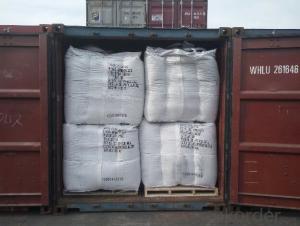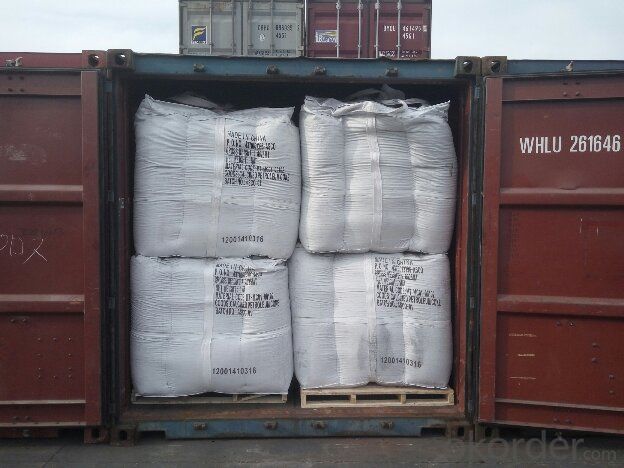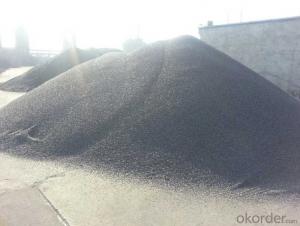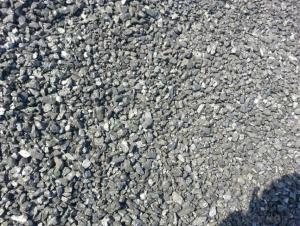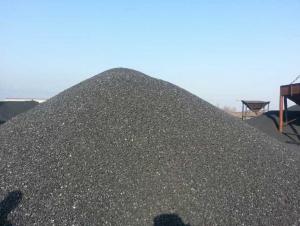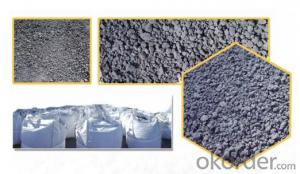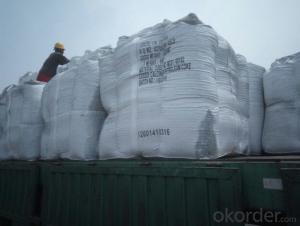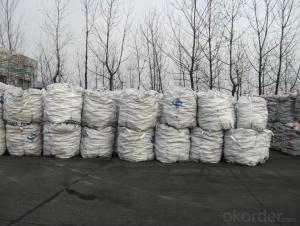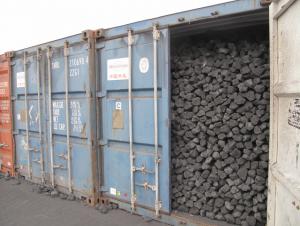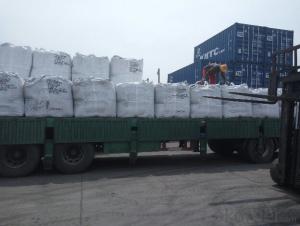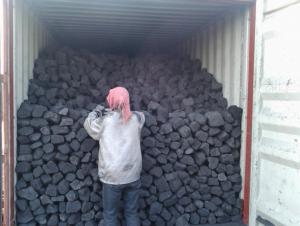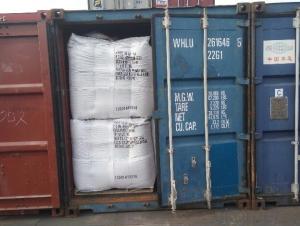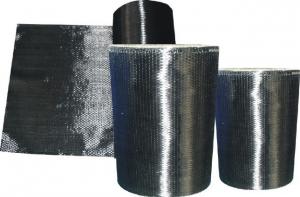12% Ash Foundry Coke for Foundry Plant Around the World
- Loading Port:
- Tianjin
- Payment Terms:
- TT OR LC
- Min Order Qty:
- 20.8
- Supply Capability:
- 1008 m.t./month
OKorder Service Pledge
OKorder Financial Service
You Might Also Like
Brief Introduction
Foundry Coke is the main fuel of melting iron in the oven. It can melt the materials in the over, make the iron reach great heat, and keep good air permeability by sustain stock column. Thus, the foundry coke should have the characteristics of big block, low reactivity, small porocity, enough anti-crush strengh, low ash and low sulphur.
The coke handled by our cooperation is made from superior coking coal of Shanxi province. Provided with the advantages of low ash, low sulphur and high carbon. Our coke is well sold in European, American, Japanese and South-east Asian markets. We are expanding more and more markets. we supply Foundry Coke long-term, its characteristic is best strength, low sulfur and phosphorus,thermal stability.
Specifications:
ASH % | 8% max | 10% max | 12% max |
V.M.% MAX | 1.5% max | 1.5% max | 2% max |
SULFUR % | 0.65% max | 0.65% max | 0.7% max |
MOISTURE | 5% max | 5% max | 5% max |
Size | 80mm-120mm,80-150,100-150mm, or as request | ||
Features
1. Our quality is always quite good and stable which is producing and packing according to customers' requirements.
2. Putting Client profile into first, achieved mutual benefit.
3. Good partner on business. It's a good and wise choice for customers' to purchase from us. It's our great honor to cooperate with you.
4. We can supply documents as follows:
- bill of loading,
-Invoice,
-Packing List
-Insurance
-standard inspection pictures of the container as specified by INSPECTORATE
-or more requested by buyer.
Pictures
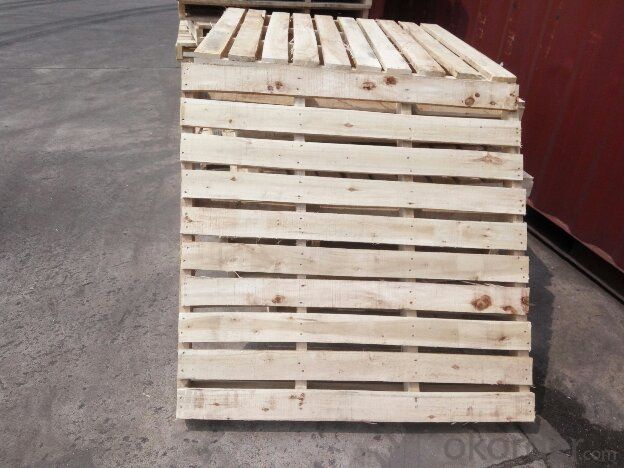
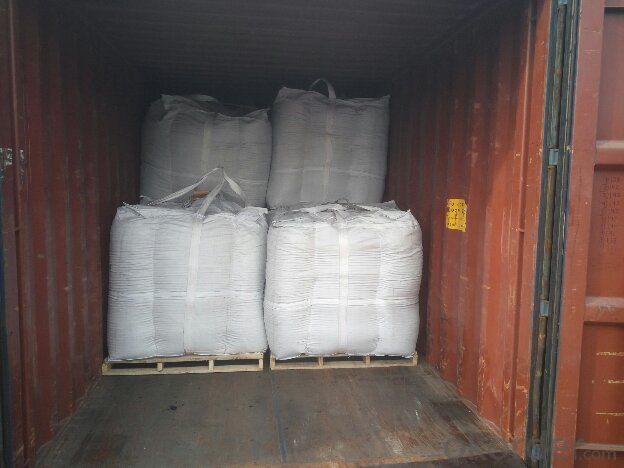
FAQ
1. What is the packing?
In 25kg bag/ In jumbo bags without pallet/ Two jumbo bags with one pallet/ or as customers’ request
2. What is the production capacity?
10 thousand tons per month
3 What is payment term?
Irrevocable LC at sight/ 20% down payment by T/T and 80% against BL copy byT/T/ or to be discussed
4 What is the service?
We will send sample to the third party(CIQ, CCIC, SGS,BV or to be discussed) for checking, and present the test certificate and loading repot of shipment.
- Q: What are the impacts of carbon emissions on the availability of freshwater resources?
- Carbon emissions have a significant impact on the availability of freshwater resources. One of the primary effects is the alteration of the global climate system. Increased carbon emissions lead to the greenhouse effect, which causes global warming. As a result, the Earth's temperature rises, leading to changes in weather patterns and precipitation. These changes in weather patterns can disrupt the water cycle, which crucially affects the availability of freshwater. Warmer temperatures increase evaporation rates, causing more water to be lost from lakes, rivers, and groundwater reservoirs. This leads to a reduction in the overall volume of available freshwater. Furthermore, global warming can exacerbate drought conditions in some regions. As carbon emissions contribute to rising temperatures, the frequency and intensity of droughts increase. This further reduces freshwater availability, as precipitation is limited, and water sources become depleted. Carbon emissions also impact freshwater resources through their effect on melting polar ice caps and glaciers. As the Earth warms, these frozen water sources melt at an accelerated rate, adding additional freshwater to the global water system initially. However, once these ice sources are depleted, the loss of freshwater will be significant. This process not only decreases the overall volume of freshwater available but also affects the quality of freshwater resources, as the melting ice can introduce pollutants and contaminants into the water. Moreover, carbon emissions contribute to ocean acidification, which has indirect effects on freshwater resources. Increased carbon dioxide in the atmosphere is absorbed by the oceans, leading to acidification. This change in the ocean's chemistry can harm marine ecosystems, including coral reefs, which are crucial for maintaining the health of coastal freshwater sources such as aquifers. To mitigate the impacts of carbon emissions on freshwater resources, it is vital to reduce greenhouse gas emissions and transition towards cleaner and renewable energy sources. Additionally, implementing effective water management practices, such as conservation measures, efficient irrigation systems, and the protection of water sources, can help preserve and sustain freshwater resources in the face of climate change and carbon emissions.
- Q: What are the impacts of carbon emissions on glacier retreat?
- Carbon emissions have a significant impact on glacier retreat. As carbon dioxide and other greenhouse gases are released into the atmosphere through human activities, such as burning fossil fuels and deforestation, they contribute to global warming. This increase in global temperatures has a direct effect on glaciers. Glaciers are large bodies of ice that form over long periods of time from accumulated snowfall. They act as natural reservoirs of freshwater, providing a crucial source of drinking water to millions of people around the world. However, as the Earth's temperature rises due to carbon emissions, glaciers begin to melt at an accelerated rate. The warming climate causes glaciers to lose more ice through melting than they gain through snowfall. This leads to a net loss of ice, resulting in glacier retreat. As glaciers retreat, they not only shrink in size but also become thinner. This diminishes their ability to store water, affecting water availability in regions that rely on glacial meltwater for drinking, irrigation, and hydropower generation. Furthermore, glacier retreat has far-reaching consequences for ecosystems and biodiversity. Glaciers provide unique habitats for various species, including plants, animals, and microorganisms, which have adapted to survive in these extreme environments. As glaciers disappear, these species are forced to adapt or migrate to other areas, disrupting the delicate balance of ecosystems. The impacts of glacier retreat are not limited to local or regional scales. Glacial meltwater contributes to rivers and lakes, ensuring a consistent flow of water throughout the year. As glaciers shrink, this flow decreases, leading to water scarcity during dry seasons. This poses a threat to agriculture, urban water supplies, and the overall sustainability of ecosystems that rely on a stable water supply. Additionally, the loss of glaciers contributes to rising sea levels. When glaciers melt, the water they release flows into the oceans, causing them to expand. This exacerbates coastal erosion, increases the risk of flooding in low-lying areas, and threatens coastal communities and infrastructure. In summary, carbon emissions have a profound impact on glacier retreat. The resulting global warming accelerates the melting of glaciers, leading to water scarcity, biodiversity loss, increased sea levels, and various environmental and socio-economic consequences. It is crucial to address carbon emissions and take steps to mitigate climate change to preserve these vital ice formations and the ecosystems and communities that depend on them.
- Q: How does carbon impact the availability of natural resources?
- The availability of natural resources is significantly impacted by carbon dioxide (CO2), which is a form of carbon. When fossil fuels like coal, oil, and natural gas are burned, they release large amounts of CO2 into the atmosphere. This excessive release of CO2 is responsible for the greenhouse effect, which leads to global warming and climate change. Climate change has a major effect on natural habitats and ecosystems. It directly affects the availability of various natural resources by causing rising temperatures and changing weather patterns. For example, higher temperatures can result in the melting of glaciers and ice caps, which affects the availability of freshwater resources for human consumption and agriculture. Furthermore, carbon emissions contribute to the acidification of oceans, which harms marine life. Coral reefs, for instance, are highly sensitive to changes in water chemistry. Increased acidity due to elevated CO2 levels can bleach and eventually kill coral reefs. This not only impacts ocean biodiversity but also affects the availability of fish and other seafood resources that many communities depend on. Moreover, climate change caused by carbon emissions disrupts ecosystems and leads to the extinction or displacement of numerous plant and animal species. This has cascading effects on the availability of resources like timber, medicinal plants, and other valuable natural products sourced from forests and other ecosystems. In addition, carbon emissions contribute to air pollution, which has adverse effects on human health. High concentrations of airborne pollutants, including particulate matter, can cause respiratory diseases and other health issues. This strains healthcare systems and reduces the productivity and overall well-being of communities. To mitigate the negative impacts of carbon emissions on the availability of natural resources, it is crucial to transition to cleaner and more sustainable energy sources, such as renewable energy. This shift would reduce reliance on fossil fuels and subsequently decrease carbon emissions, thus helping preserve and protect our natural resources for future generations.
- Q: How does carbon affect the pH of water bodies?
- Carbon can have a significant impact on the pH of water bodies. When carbon dioxide (CO2) from the atmosphere dissolves in water, it forms carbonic acid (H2CO3). This process is known as carbonation and occurs naturally in water bodies. Carbonic acid is a weak acid and it plays a crucial role in buffering the pH of water bodies. The presence of carbonic acid in water can lower the pH, making it more acidic. This is because carbonic acid dissociates into hydrogen ions (H+) and bicarbonate ions (HCO3-). The higher the concentration of hydrogen ions, the lower the pH of the water. Therefore, carbonic acid contributes to the acidity of water bodies. Additionally, carbonic acid can undergo further dissociation to form carbonate ions (CO32-). These carbonate ions can react with hydrogen ions, effectively reducing the concentration of hydrogen ions and increasing the pH of the water. This process is called carbonation and it acts as a buffer, helping to stabilize the pH of the water. Human activities, such as burning fossil fuels and deforestation, release excessive amounts of carbon dioxide into the atmosphere. This leads to an increase in the concentration of carbonic acid in water bodies, which in turn lowers the pH. This phenomenon is known as ocean acidification and it can have detrimental effects on marine life. Decreased pH caused by excess carbon can harm aquatic organisms, especially those with calcium carbonate shells, such as corals, mollusks, and some plankton species. The more acidic water dissolves their shells, making them more vulnerable to predation and reducing their ability to build and maintain their protective structures. In conclusion, carbon can significantly affect the pH of water bodies through the formation of carbonic acid. While carbonic acid contributes to the acidity of water, it also acts as a buffer, helping to stabilize the pH. However, excessive carbon dioxide emissions from human activities can lead to ocean acidification, impacting marine life and the overall health of water ecosystems.
- Q: What are fullerenes?
- Composed entirely of carbon atoms arranged in a spherical or cage-like structure, fullerenes represent a distinct category of molecules. Their discovery in 1985 sparked significant interest due to their intriguing properties and potential applications across various domains. The most extensively studied and renowned type of fullerene is buckminsterfullerene, also known as C60. This particular fullerene comprises 60 carbon atoms and takes on the form of a hollow sphere resembling a soccer ball. Fullerenes can also consist of varying numbers of carbon atoms, such as C70, C84, or even larger clusters. What sets fullerenes apart is their exceptional stability and distinctive structure. Carbon atoms within a fullerene form covalent bonds, creating a closed network of hexagons and pentagons. This configuration not only gives fullerenes their characteristic shape but also grants them remarkable mechanical, thermal, and chemical stability. Fullerenes possess an array of captivating properties that make them highly appealing for scientific research and technological advancements. They exhibit impressive electrical conductivity and can serve as efficient electron acceptors or donors in organic electronic devices. Additionally, they boast excellent optical properties, such as strong light absorption and emission, which have led to their utilization in solar cells and photovoltaic devices. Furthermore, fullerenes have demonstrated potential in medical and biological applications. Their unique cage-like structure allows for the encapsulation of other molecules within their hollow interior, making them ideal candidates for drug delivery systems. Fullerenes also possess potent antioxidant properties, making them viable contenders for various therapeutic treatments. To summarize, fullerenes represent an enthralling group of carbon-based molecules with distinctive structures and extraordinary properties. Their versatility and potential applications in electronics, energy, medicine, and other fields continue to be explored, rendering them an area of study that is both thrilling and promising within modern science.
- Q: How do plants use carbon dioxide?
- Plants use carbon dioxide through a process called photosynthesis, which is vital for their survival. During photosynthesis, plants take in carbon dioxide from the air through small openings on their leaves called stomata. Inside the leaves, carbon dioxide combines with water, which is absorbed by the roots, to produce glucose and oxygen. The glucose is used by the plant as a source of energy to carry out various metabolic processes and to grow. Additionally, plants store excess glucose in the form of starch for future use. The oxygen produced during photosynthesis is released back into the atmosphere, which is crucial for the survival of other living organisms, including humans, as we depend on oxygen for respiration. Therefore, plants play a crucial role in maintaining the balance of carbon dioxide and oxygen in the atmosphere, making them essential for life on Earth.
- Q: How do carbon emissions contribute to extreme weather events?
- Extreme weather events are influenced by carbon emissions, which contribute to climate change. When greenhouse gases like carbon dioxide are released into the atmosphere, they trap heat from the sun and cause the Earth's average temperature to rise. Human activities such as burning fossil fuels, deforestation, and industrial processes are major drivers of this phenomenon known as global warming. As the planet warms, weather patterns become disrupted, leading to an increase in extreme weather events. Carbon emissions play a role in this process in several ways: 1. Heatwaves: Higher carbon emissions result in increased temperatures, leading to more frequent and intense heatwaves. These prolonged periods of extreme heat pose risks to human health, agriculture, and ecosystems. 2. Hurricanes and tropical storms: Carbon emissions cause ocean temperatures to rise, providing more energy to fuel hurricanes and tropical storms. This leads to stronger storms with higher wind speeds and heavier rainfall, causing more destruction and flooding. 3. Droughts: Climate change caused by carbon emissions can disrupt precipitation patterns, resulting in decreased rainfall and increased droughts in certain regions. These prolonged periods of water scarcity have severe impacts on agriculture, water supplies, and ecosystems. 4. Heavy rainfall and flooding: Global warming intensifies the water cycle, leading to more evaporation and moisture in the atmosphere. This results in heavier rainfall events, increasing the risk of flooding and flash floods. 5. Wildfires: Climate change, driven by rising temperatures and drier conditions, creates favorable conditions for wildfires. Carbon emissions contribute to longer and more severe fire seasons, leading to more extensive and destructive wildfires. It's important to note that while carbon emissions contribute to extreme weather events, they are not the sole cause. Natural climate variability factors like El Niño and La Niña can also influence extreme weather. However, reducing carbon emissions and transitioning to cleaner energy sources can help mitigate the impacts of climate change and prevent further exacerbation of extreme weather events.
- Q: How does deforestation contribute to carbon emissions?
- The role of deforestation in contributing to carbon emissions is significant. When forests are cleared or burned, the carbon stored in trees and vegetation is released into the atmosphere as carbon dioxide (CO2), a greenhouse gas that contributes to global warming. Forests act as natural carbon sinks, absorbing CO2 from the atmosphere through photosynthesis. Trees and plants convert CO2 into oxygen and store the carbon in their trunks, branches, leaves, and roots. This process helps regulate the Earth's climate by reducing the concentration of CO2 in the atmosphere. However, deforestation disrupts this natural carbon storage system. The carbon once stored in trees and vegetation is released back into the atmosphere, increasing the concentration of CO2. Burning forests exacerbates this process, releasing even larger amounts of carbon through the combustion of trees and plant material. The loss of forests also leads to a decrease in biodiversity and the destruction of habitats for numerous species, which disrupts the delicate balance of ecosystems. As a result, these ecosystems become less efficient at absorbing and storing carbon, further contributing to increased carbon emissions. Moreover, deforestation indirectly contributes to carbon emissions through various means. For example, when trees are cleared, the exposed soil is exposed to sunlight and heat, causing it to dry and release stored carbon. Additionally, deforestation often leads to the conversion of land for agricultural purposes, such as livestock farming or palm oil plantations, which can increase methane emissions, another potent greenhouse gas. To summarize, deforestation contributes to carbon emissions by releasing stored carbon, disrupting the natural carbon storage system, and indirectly contributing to the release of other greenhouse gases. It is crucial to address deforestation and promote sustainable land management practices to mitigate the effects of climate change and reduce carbon emissions.
- Q: How to distinguish carbon rods to identify carbon fishing rods?
- I'm also waiting to learn! It seems all very busy, the masters are not on-line
- Q: Helmet material: ABS composites, FRP, carbon fiber, what are the differences? How to tell good from bad?
- ABS is a kind of thermoplastic material, glass steel is called composite materials, the helmet is a large part of carbon fiber prepreg epoxy resin has high temperature and high pressure molding, glass fiber and unsaturated resin molding, strength needless to say, of course, is the best carbon fiber, the price is also the most expensive.
Send your message to us
12% Ash Foundry Coke for Foundry Plant Around the World
- Loading Port:
- Tianjin
- Payment Terms:
- TT OR LC
- Min Order Qty:
- 20.8
- Supply Capability:
- 1008 m.t./month
OKorder Service Pledge
OKorder Financial Service
Similar products
Hot products
Hot Searches
Related keywords
